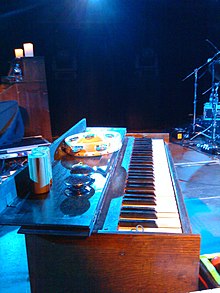Dulcitone
| Dulcitone |
|---|

|
| classification |
|
Serve idiophone keyboard instrument |
| Related instruments |
|
Fender Rhodes , Celesta , Glockenspiel , Piano |
| Musician |
| Category: keyboard player |
The dulcitone , also known as typophone , is a Scottish keyboard instrument in which the sound is produced by a series of tuning forks of various sizes. These are struck by small felt hammers and made to vibrate. The hammers are in turn moved using a keyboard. The instrument was designed by Thomas Machell of Glasgow and built by Thomas Machell & Sons in the late 19th and early 20th centuries.
Outstanding features of the Dulcitone are its portability and the fact that the tuning forks do not get out of tune, unlike the strings on a piano. However, the volume that can be achieved with the instrument is extremely limited, so that the dulcitone voice is regularly taken over by a glockenspiel .
One piece written for the Dulcitone is Song of the Bells by Vincent d'Indy from 1888.
Preserved copies exist in New Zealand , where one can be found in the Whittaker's Musical Museum, and in Germany in the private Simon Buser collection in Marburg.
In 2009, the British rock band Marillion used a dulcitone, both during the recordings for their acoustic album Less Is More and live on the tour also titled Less Is More (see photo).
The pianist Lars David Kellner premiered some pieces by the Japanese composer Rockzaemon Kazue Isida for metallophone on a dulcitone in 2018 .
See also
- Fender Rhodes (technically an electrically amplified dulcitone)
Individual evidence
- ^ Dulcitone, Thomas Machell & Sons, Glasgow, Scotland, 1897. Whittaker's Musical Museum, May 2, 2011, accessed on February 19, 2015 .
- ↑ Robert dearling: The Ultimate Encyclopedia of Musical Instruments . Carlton, London 1996, ISBN 1-85868-185-5
- ↑ premieres. larsdavidkellner.de